::: Fifth Sub-Period of the Late Treaty Period :::
|
|
 Back to Late Treaty Period.
Back to Late Treaty Period.
|
December 3, 1864-September 12, 1867
Honolulu reverted to the 5¢ United Stats postage rate for prepaid letters as soon as the American clipper ship
Seaman's Bride arrived on December 3, 1864, with news the United States stopped applying its 10¢ foreign
rate of 1864 to Hawaiian mail. The next mail shipment from Honolulu was the American bark Whistler, sailing
from Honolulu December 8, 1864, and arriving San Francisco December 31.
The Fifth sub-Period ends when the American bark Camden sailed from Honolulu for San Francisco on September
12, 1867. The next mail shipment following the Camden was carried by the American steamship Idaho of
the North Pacific Transportation Company, under contract with the United States Post Office Department, ushering
in the Sixth sub-Period.
During the Fifth sub-Period, mail was carried to San Francisco primarily by sailing ship with few opportunities to
send mail by a steamship. No vessel was subsidized with a mail contract in this time frame. Letters sent East from
San Francisco were taken by the daily overland coach via Salt Lake. Mail went via Panama if someone inscribed the
cover with an instruction to send it that way, or if the overland route was blocked by snow or Indian hostilities.
Pre-Paid Letters
|
|
|
Seen above is a typical prepaid cover from the Fifth sub-Period, showing postage prepaid at the 5¢ rate (3¢
postage plus a 2¢ ship fee) to a United States destination inland from San Francisco. This cover is postmarked
October 7 at Honolulu and October 28, 1865 at San Francisco, and was carried to San Francisco on the American bark
D. C. Murray, sailing October 7, 1865, from Honolulu and arriving San Francisco October 27.
|
Collect Letters
By the Whistler on December 8, 1864, Honolulu forwarded the balance of collect mail stacked up since the
error periods began. Some collect mail was sent out on November 23, after Honolulu learned collect mail from
Hawaii was accepted by the United States even while it was imposing the 10¢ rate. Whatever collect letters were
being retained at outer island offices were sent over to Honolulu and shipped out with the next vessel. With
restoration of the 1863 United States rate, collect letters to inland destinations in the United States should
have been charged 6¢ for double the ordinary rate. However, San Francisco instead rated collect letters 8¢ by
adding the 2¢ ship fee to the doubled rate despite the 1863 law stating the doubled rate included the ship fee.
Supporting authority for the 8¢ rate has not been found, but it persisted for the duration of this sub-Period.
In the Fifth sub-Period, collect letters declined to only a small percentage of letters. Eight collect letters are
recorded during this sub-Period. Of those, one to a San Francisco resident was rated 6¢, and seven to other
destinations were rated 8¢ (6¢ postage plus a 2¢ ship fee) or 14¢ (12¢ postage plus a 2¢ ship fee).
Please E-mail (scott312@earthlink.net) me if you have additional information on why San
Francisco added the 2¢ ship fee to collect mail in 1865-1867.
|
|
|
Above is a typical stampless collect cover showing the puzzling 8¢ rate. A manuscript docket note tells us the
letter was dated August 28, 1864, although the letter is no longer with the envelope. The letter was written early
enough to have been shipped to San Francisco on board the Smyrniote on September 7, before the error rate
periods began in Hawaii. Apparently this letter reached Honolulu sometime after September 7. By the time the
letter could be shipped to San Francisco, the Honolulu Post Office learned the 10¢ rate was being applied to
Hawaii mail and, also, came to doubt whether collect letters would be admitted in the United States mail without
charging postage to the Honolulu Post Office. Thus, the letter was detained at the Honolulu Post Office. Once
Honolulu learned collect letters still could enter the United States mail with unpaid postage charged to the
recipient, collect letters being held were forwarded. The letter shown above is postmarked December 6 at Honolulu
and January 3 at San Francisco, proving it was carried by the American bark Whistler, departing Honolulu
December 8, 1864, and arriving San Francisco December 31, with the first mail shipment from Honolulu in the Fifth
sub-Period.
|

|
The collect letter illustrated above was dated at Honolulu on December 15, 1866, according to the manuscript
docket note. It was postmarked January 3, 1867 at San Francisco, proving it was carried to San Francisco on the
American bark Comet, departing Honolulu December 15, 1866, and arriving San Francisco January 3, 1867. This
cover also shows the puzzling 8¢ rate and the SHIP mark. A blue pencil "8" probably was applied at New Bedford as
a reminder to collect 8¢ from the recipient.
|
About Fifth sub-Period Covers
The census of covers records 215 covers sent from Hawaii in this sub-Period. Prepaid letters dominate the
sub-Period, with 205. Two covers were sent privately and 8 covers were sent with United States postage collect.
Two of the 8 collect covers were franked with 5¢ Hawaiian stamps to pay Hawaiian postage. Five of the 8 collect
letters were stampless (5¢ Hawaiian postage was paid in cash). One prepaid cover was stampless, so only six
stampless covers are recorded from this sub-Period. These numbers contrast sharply to earlier Periods when
stampless covers accounted for 50% or more of recorded covers and unpaid letters accounted for 25% to 40%.
Mail volume increased as the United States emerged from Civil War. In 1865, only 51 covers are recorded, but in
1866, 95 covers are in the census, in 1867, 98 covers are recorded (66 in the first eight months belonging to the
Fifth sub-Period).
An unfortunate change to note as we move to this sub-Period is the increased number of faked or altered covers.
Prior to 1865, the incidence of faked or altered covers is quite small. However, in addition to the 215 genuine
covers there are four fake covers, made up to look like they have real postmarks. Among the 215 covers genuinely
sent through the mail from Honolulu are 14 altered covers where stamps not on the covers when they were mailed have
since been added, either to replace missing stamps of a similar type or to add a stamp that never was on the
cover. The altered covers at least have genuine postmarks. Twenty-six of the 215 genuine covers are missing one or
more stamps (not counting altered covers where stamps were added to replace missing stamps).
Hawaiian Stamps On Cover In The Fifth sub-Period
Among the Hawaiian stamps found on covers sent abroad in this sub-Period, the 1¢ Numeral Issue printed on laid
paper (Scott No. 23) is rarest - only one cover is recorded bearing that stamp and it happens to be on a foreign
letter sent in this sub-Period (See Advertiser Lot 409). An off-cover example of the 1¢ Numeral issued in 1864 on
wove paper (Scott No. 19) was canceled with the San Francisco cog cancel, but no cover sent in the foreign mail
with that stamp is recorded.
|
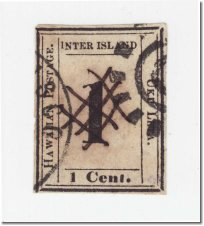
|
This 1¢ Numeral printed on wove paper is Scott No. 19, printed in 1864. The San Francisco cog cancel proves it
was used to frank a letter sent in the foreign mail, but no foreign mail cover bearing this stamp is recorded.
|
|
Besides the 1¢ Numerals, other Hawaiian stamps found on cover in this sub-Period are:
- Scott No. 9, the 5¢ 1861 Boston Engraved Issue - 18 of the 50 covers
franked with this stamp were mailed in this sub-Period.
- Scott No. 21, the 5¢ "Hawaiian Postage" 1865 Numeral, franked 41
covers - plus an odd cover with an impression (but not the stamp) of Scott No. 21 on it and no stamps. Forty of
the Scott No. 21 covers were mailed in this sub-Period.
- Scott No. 22, the 5¢ "Interisland" 1866 Numeral, was used to frank
only 11 recorded covers, all of them sent in this sub-Period.
- Scott No. 27, the 2¢ Boston Lithograph stamp, appears only on 1 foreign mail cover in this sub-Period, but
is found on numerous local and interisland covers.
- Scott No. 31, the 2¢ 1864 Bank Note Issue, is found on 10 covers (including one cover in combination with
the Scott No. 23 cover and another cover in combination with the Scott No. 27 cover) in this sub-Period, but
this stamp also franked 4 covers in the Sixth sub-Period, multiple covers in the Convention Period and numerous
local and interisland covers.
- Scott No. 32, the 5¢ 1866 Bank Note Issue, franked 41 covers in this sub-Period, plus numerous covers in
later Periods.
|
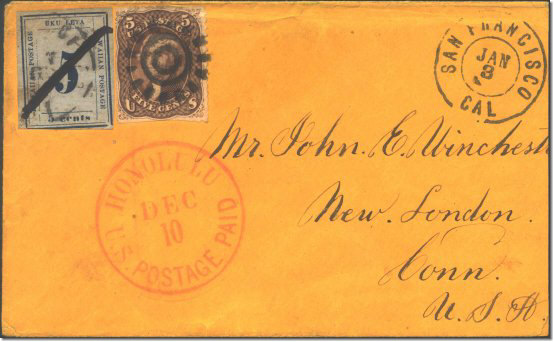
|
The cover shown above was postmarked December 10, 1866 at Honolulu and January 3, 1867 at San Francisco, this
cover was carried to San Francisco on the American bark Comet, leaving Honolulu December 15, 1866 and
arriving San Francisco January 3, 1867. This cover is a typical prepaid cover, with the Hawaiian 5¢ Scott No. 21
paying the Hawaiian rate and the 5¢ No. 76 paying the United States rate.
|
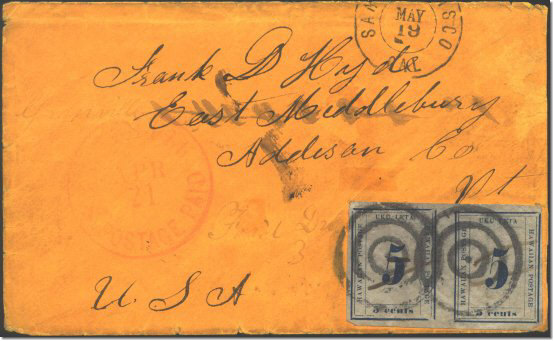
|
Postmarked April 21, 1866 at Honolulu (barely visible above the manuscript "U.S.A.") and May 19 at San Francisco,
the letter illustrated above was carried to San Francisco by the American bark Smyrniote, sailing April 21,
1866 and arriving May 17. The cover has no missing stamps so the sender prepaid United States postage with 10¢
value in Hawaiian stamps (two 5¢ Scott No. 21 stamps). Hawaii's Postmaster General specifically recommended the use
of Hawaiian stamps to prepay some or all of the United States postage if appropriate United States postage stamps
were unavailable. In these cases, the letter was listed as prepaid in the way bill sent with the mail bag. Any
United States postage unpaid by United States postage stamps was charged to the Honolulu Post Office account at
San Francisco. The Honolulu Post Office applied the "U.S. Postage Paid" postmark to this cover, and entered the
letter as prepaid in the way bill sent with the letter bag. United States 5¢ postage was charged to the Honolulu
Post Office account at San Francisco.
|
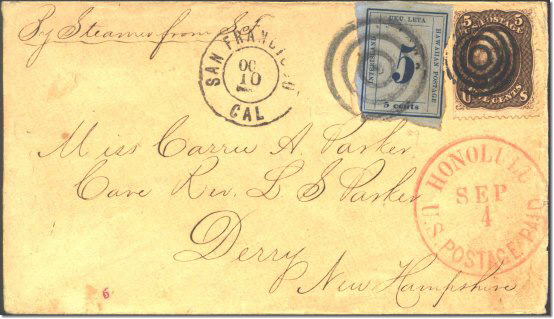
|
Postmarked September 4 at Honolulu and October 10 at San Francisco, this cover was carried to San Francisco on the
Columbian bark Sarita, sailing from Honolulu on September 5, 1866, and arriving San Francisco October 7.
Here is one of the eleven Scott No. 22 covers, seen with the United States 5¢ (US Scott No. 76). It also is marked
in manuscript to go from San Francisco by the steamer via Panama.
|
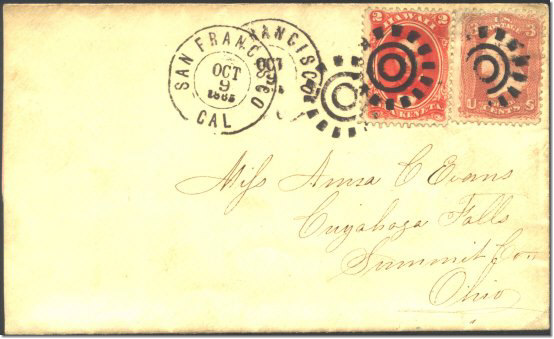
|
Postmarked at San Francisco on October 9, 1865 with no Honolulu postmark. This cover was carried to San Francisco
by the American bark Onward, departing Honolulu September 16, 1865, and arriving San Francisco October 7.
Other mail in the same shipment was also postmarked at San Francisco on October 9 along with this cover, helping
to prove this cover originated in Hawaii. Hawaii's Postmaster General told country postmasters to prepay the
United States ship fee with 2¢ Hawaiian stamps when they were out of 2¢ United States stamps. For this letter, the
5¢ Hawaiian postage was paid in cash, the 2¢ Scott No. 31 paid the ship fee, and the United States 3¢ letter
postage was prepaid with the 3¢ US Scott No. 65. At San Francisco, the letter was treated as prepaid, and Honolulu
was charged 2¢ through the account system.
|

|
Postmarked December 15, 1866 at Honolulu and January 3, 1867 at San Francisco, this cover bears the Hawaiian 5¢
Bank Note, Scott No. 32 to pay the Hawaiian rate and US Scott No. 76 to pay the United States postage. Note the
pen cancel on No. 32, indicating the letter originated at a country post office outside Honolulu. This cover was
carried on the Comet in the same mail bag as the stampless Wood & Nye collect cover illustrated above. The
Hughes correspondence includes several covers in this sub-Period.
|
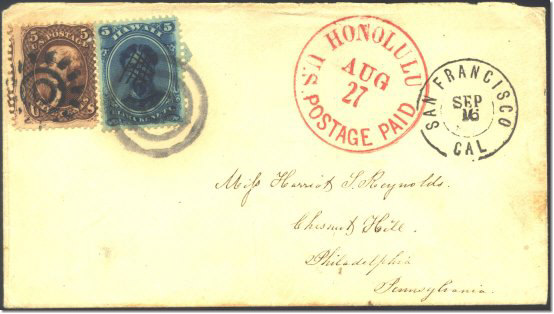
|
Postmarked at Honolulu on August 27, 1867, and carried to San Francisco by the American brig Woodland in the
penultimate mail bag of the Fifth sub-Period, departing Honolulu August 27, 1867, and arriving San Francisco
September 16. Note the cross-hatch cancel on the Hawaiian 5¢ stamp, applied at one of the country post offices
outside Honolulu.
|
United States Stamps On Cover In The Fifth sub-Period
Covers franked with United States stamps in this sub-Period usually bear the United States 5¢ stamp issued in 1863
(US Scott No. 76). Recorded from this sub-Period are 127 covers bearing this stamp, either with or without a
Hawaiian stamp or another United States stamp. Other United States stamps recorded in this sub-Period were the: 1¢
(US Scott No. 63 - 7 covers), 2¢ Black Jack (US Scott No. 73 - 24 covers), 3¢ (US Scott No. 65 - 45 covers), 10¢
(US Scott No. 68 - 8 covers), 12¢ (US Scott No. 69 - 3 covers), 24¢ (US Scott No. 70 – 2 covers - and US Scott No.
78 – 2 covers), and 30¢ (US Scott No. 71 - 3 covers), plus three 3¢ stamped envelope (US Scott No. U58 – 1 cover
– and US Scott No. U59 - 2 covers). The cover count duplicates covers with multiple kinds of stamps so the numbers
adds to more than the total covers for the sub-Period. Starting in December, 1865, Hawaiian Postmaster General
Brickwood refused to send United States postage stamps to outlying offices. Postal patrons and local postmasters
could obtain them privately through stationery or book stores where they were sold. The Honolulu Post Office
purchased supplies of United States stamps from local merchants in Honolulu.
|

|
A 5¢ United States Scott No. 76 stamp franked this cover postmarked at Honolulu on November 17, 1866, and carried
to Honolulu on the American bark Ethan Allen, departing Honolulu November 17, 1866, and arriving San
Francisco December 4. A letter from Mrs. Clough to Captain Clough is illustrated below in the Inward covers.
|

|
Carried to San Francisco on the British brig Ann Sanders, departing Honolulu August 16, 1866, and arriving
San Francisco September 16. This cover was postmarked at Honolulu on August 15, 1866, franked with a United States
10¢ stamp (US Scott No. 68) to pay the United States 10¢ rate for a letter sent from San Francisco to Victoria,
Vancouver Island, headquarters of the Hudson Bay Company. That rate included the ship fee from Honolulu. A
manuscript note states it was received September 24. Hawaiian 5¢ postage was paid with cash.
|

|
Illustrated above is a letter sent to London, England, in 1866, franked with a United States 2¢ Black Jack (Scott
No. 73) to pay the ship fee to San Francisco, and two United States 24¢ stamps (U.S. Scott No. 78), for the treaty
rate from San Francisco to Great Britain. Hawaii postage of 5¢ was paid with cash. The letter was postmarked at
Honolulu on January 22, 1866, and was sent to San Francisco on the American bark Whistler (January 22
sailing, February 7 arrival) carried to, and was postmarked at San Francisco on February 8, 1866, before being
sent to London via New York City.
|
Mail For San Francisco Addressees In The Fifth sub-Period
Thirteen covers to San Francisco are noted in the Fifth sub-Period, all sent prepaid. The correct rate until
May 1, 1865 was 2¢ for the drop letter rate plus 2¢ for the ship fee. On May 1, 1865, the United States reduced
the drop rate to 1¢, so from that date, the correct rate was 1¢ for the drop rate plus 2¢ for the ship fee.
Nonetheless, in the 1¢ drop rate period letters from Hawaii were sometimes charge 3¢, at other times charged more,
4¢, 5¢, and even 6¢. Please E-mail (scott312@earthlink.net) me if you can explain the
San Francisco incoming rate in this sub-Period.
|
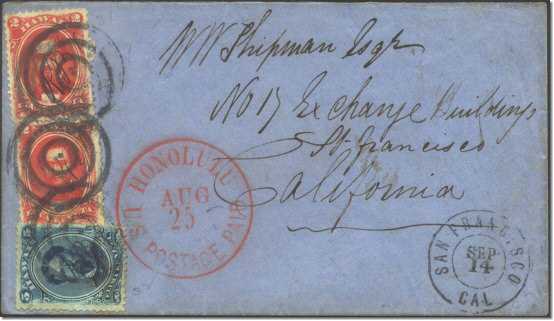
|
Carried to San Francisco on the American bark D. C. Murray, departing August 25, 1866, and arriving San
Francisco September 13. The Hawaiian 5¢ rate and the United postage was prepaid with Hawaiian stamps, but the
United States postage needed was overpaid by 1¢.
|
Inward Covers In The Fifth sub-Period
United States postage of 3¢ conveyed a letter from anywhere in the United States to San Francisco. Inward covers
sometimes were addressed to the care of an agent in San Francisco. The lack of a mail contract for transit to
Hawaii meant someone needed to pick up the mail at the San Francisco post office and deliver it to a ship bound
for Honolulu. The Honolulu Post Office employed a mail agent at San Francisco for that purpose. To receive special
attention for their letters, knowledgeable people addressed them to a specific agent in San Francisco. Inward
letters were charged Hawaii postage of 5¢ plus 2¢ sea postage for bringing the letter to Honolulu.
|

|
An 1865 inbound letter addressed to McRuer & Merrill at San Francisco, and forwarded to Honolulu by that firm in a
private letter bag. No Hawaii postage was charged on this letter because the addressee was a government minister
entitled to free Hawaii postage.
|

|
An inbound letter to Capt. Benjamin Clough of the Ship Northern Light and carried in the official mail bag.
Note the manuscript 7¢ indicating the amount to collect upon delivery. A cover from Capt. Clough to his wife is
illustrated above.
|
|
 Back to Late Treaty Period.
Back to Late Treaty Period.
|
|

|
|
Copyright © 1999 - 2010 POST OFFICE IN PARADISE. All rights reserved.
|
|